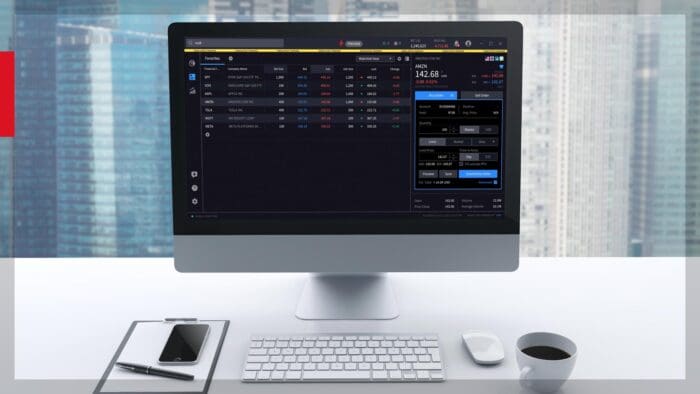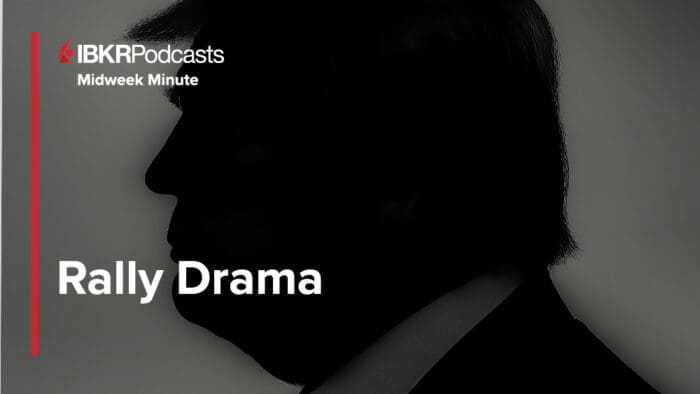Presenter: Nancy Nelson, CPA
Nancy holds an MBA from Kelley School of Business, Indiana University, Bloomington. Nancy began her career in finance at a Fortune 100 company, worked in the Family Office area and at Ernst & Young LLP, before joining Interactive Brokers Group as Tax Director. She is a licensed CPA in New York and Connecticut. In her less taxing moments, Nancy breeds competition dogs, competing in confirmation and agility. Her dogs work at these sports and as Therapy Dogs. They hold several American Kennel Club titles and include an AKC Grand Champion.
Today we’re talking about your retirement, and specifically retirement savings accounts. Believe it or not, whether you’re 20 or you’re 50, retirement is here before you know it, and having adequate savings is imperative to being able to enjoy that retirement in a way that you want to do it.
You’ll have hobbies, you’ll have activities, and sadly those all So, today our focus is on Qualified Retirement Plans. We are going to talk about IRAs, we’ll talk a bit about 401Ks, we’ll talk about Roth IRAs, but we won’t be talking much about Pension Plans. And that’s as the specific reason behind that is that first of all, pension plans are generally very specific to your employer, and so there’s no, although there’s some broad generalizations, there’s no real generalizations to them.
Pension Plans
The plan dictates what can happen with it and how you can take that money. So, to try and divvy that up amongst the millions of employers, you can’t do it. The second thing is, is although there’s a lot of industries that still have pensions, that has faded from the landscape over the time frame of the last 30 to 40 years.
Fewer and fewer companies get pensions, most of them offer a 401k. So, let’s talk about those 401Ks and kind of give a little history here, and I’m going to refer to my notes a little bit because I can’t remember all the dates. Congress in 1974, created the Individual Retirement Accounts that we commonly refer to as IRAs, and that’s how we’re going to talk about them, to allow pretty much every American to save for retirement.
If you were working, you had earned income of any kind, you could save for retirement. In 1978, Congress created 401k plans, which allowed the employers to provide a plan for you to put pretax money, so the money that you hadn’t paid taxes on, into this plan for savings. In some cases, they matched that money.
They might have matched none of it, 10% of it, all of it, different ways. It could have been matched in stock. It could have been matched in cash. So, if we look at the time frame of American industry, that really isn’t that long ago. Doing that shifted some of the burden for saving for retirement from the company to the employee. So, you could opt out of the 401k, but a lot of times companies dropped whatever pension plan they had at that time, did away with it, moved to the 401k to allow for employee participation or more employee self-funding. If you chose not to participate, you, you had nothing.
When you retire, essentially, or whatever was left of that little pension that they hadn’t dissolved that you were working before they dissolved that. Just to give you an example of that, I had an employer that dissolved a pension, and had I not participated in the 401k, I would be at my retirement receiving 500 a month.
I don’t know about you, but I know I can’t live on $500 a month before I pay taxes on it. It is taxable, so it’s really important to think about what you, you’re going to need in the future. So, we did some more work in 1981, and we expanded the original contribution amounts for IRAs and 401ks were really very small, $2,000.
In 1981, they raised those and indexed inflation, to some extent. And in 1997, They added Roth IRAs. Now Roth is named after Senator Roth who created the idea, and we always just refer to them as Roth IRAs. They have same concept, except the money going into a Roth IRA, you pay tax on first, but when it comes out, it’s tax free.
Now, there’s some rules around that, obviously, because, you know, the IRS likes nothing more than rules. It also has some income limitations. So, if you make over a certain amount, you can’t contribute directly to a Roth. There’s still a little bit of a backdoor way around that, and we’ll talk about that in one of the lessons later.
SECURE Acts
Over the years, we’ve had changes, we’ve had index inflation, we’ve had some adjustments, but, in 2019 and 2022, we had the SECURE 1 Act and the SECURE 2 Act. It stands for Securing a Strong Retirement. they made some significant changes.
Significant changes to what we had is what we needed to take as distributions. The age at which you needed to take that distribution and the contribution limits. I’m just going to give a little touch on pension plans here and talk about defined contribution and defined benefit plans.
And until the 1970s, this was what everybody had, especially if you worked in a union heavy and that was not what we consider a union heavy industry today. Today, the car manufacturers, and steel, and a few other industries, coal, are still very heavily unionized. But there were a lot more unions in other industries in the 70s that we no longer consider, and it included their professionals. So, for example, the cereal industry, the cereal plants, the food plants were all unionized plants. Not so much anymore. but you do hear of it coming back. There are people that want to unionize Starbucks.
Most governments, cities, towns, states, still have a pension driven system. They don’t offer 401k savings, they offer pensions. Now those pensions have changed some, where they have both contributions from the employer and contributions from the employee, but every plan is different.
You may be able to retire after 20 years if you’re a certain age. You may be able to retire after 5 years if you’re a certain age. You may need to have 30 years in if you’re a certain age. You may need to put your plan into what they call a drop plan. There are all sorts of options here, which is one of the reasons that we’re choosing not to cover that because again, they are very locational and very plan specific, but if you are a government employee, that doesn’t mean you can’t have an IRA or a Roth IRA. You can have both, and you may need both, because depending on your savings when you get ready to retire. You may not have enough money unless you have both.
So, recently it was reported in order to feel wealthy in the United States, you should have $2.5 million dollars. That was reported by CBS News. And so, think about what $2.5 million dollars is and then take a look at your bank balance and say, If I need half of that to retire, to live comfortably, because I probably don’t need to be wealthy, I need to have over a million dollars.
And for many, many years, the million-dollar mark was your threshold for savings for retirement. Would say, depending on the part of the country you live in, and your lifestyle, that’s probably not true anymore. You probably need more. I also think the younger you are, you used to be in the 70s and 80s because of the underfunding of Social Security and Medicare, that it was felt that people that reached retirement age in the current decade or the next decade would no longer receive Social Security or would not receive full Medicare coverage.
Medicare
And one of the things to remember is We think of Medicare as being free, but Medicare is not free. If your income is at a certain level and that level is really, really low. I don’t know many people who make under $22,000 in this country. Medicare is not free. You have to pay for it, and it may be that you’re eligible for Medicare at age 65 but you may still be in a situation where you don’t want to start taking your Social Security for various reasons and that’s a separate discussion.
But that means every month you need to write the government a check for your medical. These are things that people don’t tell you when you’re 20. So, these are things that you need to think about and anticipate in your savings now.
401k and 403b Plans
So, let’s talk about 401k plans and 403b plans. They’re essentially the same thing. 401ks are offered by Standard employers, the companies that you and I work for that are out in the public. 403B plans is the not-for-profit equivalent of a 401k plan. So, if you happen to work for a not for profit, a hospital, a charity of some kind, there are a lot of not for profits that employ a lot of people.
403b plans work, have almost all the same attributes as a 401k plan. For the purposes of this lesson, we’re going to talk about that. About them as if they’re one and the same. So, if you hear me say 401k and you have a 403b, just switch it in your mind.
Let’s start with those 401k plans. Traditional 401k plans, which is what almost all of us have initially, you take your paycheck, you say, how much would I like to contribute, and your employer probably may have limits on that, and say, every paycheck I want 10 percent to go out and go into my 401k plan, and that 10 percent comes out.
Your employer could, they don’t have to, match that in some way. So, your employer might match the first 7, 500 of your contribution. So, if you put in $7,500, they put in $7,500, all of a sudden, you’ve got $15,000. Whatever your employer puts in is essentially, in some respects, free money to you. Because, although you’ll have to pay tax on it after you pull it out, you didn’t do anything to get that money.
And be very careful as you look at your matching programs, how they work. Sometimes they put little tricks in them. So that says, I’ll match 10%, but once I max out to a certain level, I’ll stop. But if you pace your contributions over the course of the year right, you get that full 10%.
But if you front end load it because you want the money to, you know, go on vacation during the summer or something, the cash flow, it doesn’t work. So those are things to be aware of. Then once you get all that money in there, 401k plans. Usually there’s a vesting period and that varies by employers.
Five years is the max it can be. You get to keep every penny that your employer put in at that point. And if you leave that employer, depending on the employer that you go to, you can take whatever you’ve got in that 401k plan, move it to the next employer’s 401k plan. Or you have another option. Some 401k’s plans allow you to leave the money there.
Some don’t, once you leave the company. You can put that into an IRA and have it sit there. If you take it out completely, It’s taxable. Taxable, and if you’re under age 59 and a half, subject to a 10% additional penalty for early withdrawal. So, that’s something to think about. You could have 20, in a 401k plan, very quickly.
You go to leave, you say, oh, I’ll take that money, and I’ll go buy myself a new one. Small car that’s used. And you say, I’m going to take this. Well, you can take it, but you now owe federal tax on that money if it’s a traditional 401k and if you live in a state that has state tax, you owe a state tax on it, and at the federal level, you owe an additional 10% penalty.
Think about that carefully if you change jobs, but there are options. You don’t have to leave it there. If the new employer allows it, you can move it into the new plan. If it doesn’t allow it, you can, take it out and roll it directly into a IRA. Now the key thing here, you don’t want to touch that money.
You don’t want, to whoever holds that 401k plan, write you a check, although you can, and then take that check and create an IRA. You want it to go from the 401k plan straight to wherever the IRA is opened at, because there are rules about that.
Roth 401k Plans
There are a couple other things that we want to talk about. In 2006, they created Roth. 401k plans. What this allows, it’s the same concept as a Roth IRA, has no income limitation. You pay the tax on the money as you put it into the 401k plan, and when you take that Roth 401k out and distribute the money out of it, it’s not taxable to you, unlike the traditional 401k. There’s good news and bad news about that and you have to think about that. Yes, you’re paying the tax while you have more income to pay tax and cash flow to pay tax because you’re working, but on the flip side of that, and you’ll get the money when your retired tax free or leave it to your heirs’ tax free.
There’s a couple of things that might be downsides about that. If you’re earning wages, chances are you’re in a higher tax bracket than you will be when you retire because you won’t have those earnings. So, it might not be the best decision. You might be better off to let it be in the traditional IRA and pay the tax later.
There’s another upside though. If you have a Roth 401k and then roll it to a Roth IRA, you don’t ever have to take a distribution, and you can leave that to your heirs, and they won’t pay tax. There are all sorts of considerations. So, you need to look not only at yourself, and your plans for the future and retirement.
But who your heirs are, their plans for the future, and how you want to leave them money.
Solo 401k
There are Solo 401k plans. They’re currently kind of a hot thing for, investors. I’m going to tell you that they’re rather inflexible if you create them. If you’re a sole business owner, it’s only you, you can have a solo 401k, and it only covers you.
That’s good and it’s bad, but it has some limits. If you have another employee, then you have to maybe create a plan for them and then you got two plans to manage and there’s other options. Additionally, you’re allowed to contributions up to 25 percent of earned income of the business.
That’s great, but you can also do that to a SEP IRA. And they’re very similar, but it allows you a little bit more expandability for your employees. You literally cannot have an employee. Solo 401k might be great when you’re first starting, but then you grow your company and you have two or three employees, and then you’re into the situation where it doesn’t work anymore.
So that’s a consideration. Now maybe if you’re tail end of the business and you’ve got maybe something that you’re doing in retirement that generates income, solo 401k might work for you. There are some other considerations with that, but a SEP will work too. And SEP stands for Self Employed IRA. We’re going to talk about them as SEPs, that’s how everybody talks about them.
Traditional and Rollover IRAs
So, let’s talk about traditional and rollover IRAs and the difference between. So, we’re going to start back with the traditional IRA. This is money that we put in, usually after tax, but it could be before tax. There are rules and income rules about that.
And really, to detail that doesn’t make a lot of sense because there’s something that changes the income limits every year because they’re inflation indexed. So, if you’re going to look at it, you can go on the web and look it up and see what those income limitations are.
But traditional IRAs may have before tax funds and after-tax funds in them. Well, maybe when you’re young. Your income is low enough that you can put before tax income into them. But as you grow older, your income gets higher. Or, if your employer offers you a 401k and you put money into an IRA in addition to that, and you can, you’re going to put in after tax money.
One of the things that we think about is that when we take the distribution, that’s going to all be taxable. But that’s not true. A traditional IRA has tax basis to it if you’ve put in after tax money. So, I have this one form that I call the most underused form in all of the IRS’s forms for 1040s, and it’s form 8606.
Traditionally, if you had a 401k and you rolled it over to an IRA, you needed to put that money into a rollover IRA. And there was an, an account called a Rollover IRA, that really went by wayside in 2008 when they created the Roth.
Roth 401k and Roth IRA
And what they did is basically said it doesn’t matter long as the accounts match. So, if you start with a traditional 401k, you must roll it to a traditional IRA. If you start with a Roth 401k, you must roll it to a Roth IRA. So, it’s a matching and if any of you are accountants, there’s the matching principle that you learn day one in accounting 101 and that’s what it is.
It’s essentially Traditional to Traditional Roth to just match them up. You may have a rollover IRA; it might be an old one. There’s no reason you can’t push that together if you have another Traditional IRA or another Roth IRA that isn’t a rollover and push those together. There’s one remaining constraint.
You’re only allowed one rollover a year. So, if you decide you’re going to roll, you have a bunch of accounts. You’ve got to do this strategically. if you do a trustee-to-trustee transfer. So, you, let’s give the example of, you had your brother-in-law managing your accounts, and I like to make these fun, and he, beat you at golf and you decided to pull all your money from him.
And so, you’re going to move from him managing your account to your best friend Joe. You don’t want to take that money out of your account, get a check, and then give it to Joe. You want your brother-in-law’s firm to do a trustee-to-trustee transfer from your brother in law’s firm to Joe’s firm, never touching the money.
Some people would say, but I have 60 days to take that check and decide where I want to put my money. You absolutely do. But the problem is, is that reporting this to the IRS becomes much more of a nightmare if you take those 60 days. And it’s because of the way the fact that computers review tax returns and compare information, and humans don’t anymore.
So, the computer says, “Oh! so and so took a IRA distribution and didn’t, pay tax on it, so red flag, red flag, red flag, I’m going to send them a notice”. Doesn’t matter that you, in May, will get that 5478 that says I made this contribution. You filed your tax return in April before you get that notice.
So, you’re going to have to deal with some correspondence with the IRS, likely, if you do that. Who wants to do that? And so, let’s, let’s stop the red flag right out, do it the right way, trustee-to-trustee. You don’t need to take a check and take that money. A Roth IRA is after tax contribution. It’s, open to taxpayers only under a specific threshold of income.
That threshold’s indexed, so we’re not going to say what it is at this. One key caveat about Roth IRAs. Yes, you don’t pay tax on them when they’re distributed to you, or they’re distributed to your heirs. But here’s the kicker, that moneys got to be there for five years. That account’s got to be the first contribution has to be five years in the account before you can take an account.
So, if you are 62, and you think you’re going to retire at 65 and want to start taking this money, that’s only three years. And so, you’re going to have to wait two years before you can touch that money, or even if you needed it. So, there are exceptions to that for special needs, but, for the most part, that’s what you’re looking at.
So, a lot of people forget that five-year rule. If you violate the five-year rule, pull out that money early, you, are subject to tax on the increase in the value of the account. So, if you put in 10, It’s now worth $13,000 and I’m just picking numbers out of the air. You would pay tax on that $3,000.
SEP IRA
The final thing I want to talk about is SEP, self-employed IRAs. It’s intended for small business and self-employed individuals. They’ve been around forever. Their predecessor was called the Keogh Plan, which was named after a representative. In Congress, and that goes back to the late 60s, that plan, and they just morphed into these SEP IRAs.
There are specific limits based on the earnings of the self-employment for the person contributing. That limit is, again, one of those index numbers that indexes every year, how much you can put in. It’s a formula of what you made versus the maximum.
Other Plans and Inherited IRAs
And there’s some other plans. There’s a lot of other littler, smaller simples, simple IRAs, a lot of those under there. But the rules in general for those mirrors what you can do in a traditional Roth IRA, or a SEP IRA. The difference comes at the contribution end, and employer end, and that I don’t think is what we’re trying to talk about here today.
We’re talking about getting that nest egg for retirement. you also might inherit an IRA. And when we get to the distribution rules, we’re going to talk about inherited IRAs. And there’s some very specific rules depending on who you inherit from, and, how old you are, and whether you’re a minor child, and different things that the Secure 1 and Secure 2 Acts significantly changed when you inherit an IRA.
We’re going to talk to that, a little bit later when we talk to the distributions. I hope you enjoy, this venture down this road through the IRA accounts and through the savings accounts for your retirement.













Join The Conversation
For specific platform feedback and suggestions, please submit it directly to our team using these instructions.
If you have an account-specific question or concern, please reach out to Client Services.
We encourage you to look through our FAQs before posting. Your question may already be covered!